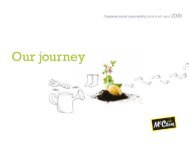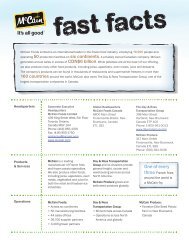From the Ground Up - McCain Foods Limited
From the Ground Up - McCain Foods Limited
From the Ground Up - McCain Foods Limited
You also want an ePaper? Increase the reach of your titles
YUMPU automatically turns print PDFs into web optimized ePapers that Google loves.
Potato variety and seed potato production<br />
Although hundreds of potato varieties exist, breeders continue to<br />
search for new, hardier ones. Once a new variety is created, it takes<br />
years of experiments to find <strong>the</strong> best ways to grow it. Varieties that<br />
do well in one region may not perform as well in o<strong>the</strong>rs. Only when<br />
<strong>the</strong> best management practices are perfected is <strong>the</strong> new variety<br />
recommended for french fry production.<br />
3. Each potato variety has its own<br />
characteristic sprout, which emerges<br />
when <strong>the</strong> tuber is exposed to<br />
sunlight. Shown here is <strong>the</strong> Kennebec.<br />
7. Each true seed in a berry resulting<br />
from cross-pollination is that of a new<br />
variety, one with characteristics of<br />
<strong>the</strong> parent plants.<br />
11. To speed up multiplication of new<br />
plants, a tissue culture is done by<br />
cutting <strong>the</strong> stems and planting <strong>the</strong>m<br />
in test tubes.<br />
1. Each potato variety has a distinctive<br />
colour and shape of flower. The sparse<br />
white flowers of <strong>the</strong> Russet Burbank<br />
are star shaped.<br />
4. A Russet Burbank sprout. 5. Pollen is extracted from <strong>the</strong> potato<br />
flower an<strong>the</strong>r. Cross-pollination can<br />
produce new varieties with characteristics<br />
desirable for potato processing.<br />
8. Potato plants are grown from <strong>the</strong><br />
tiny seeds, in a greenhouse.<br />
12. These test tubes are kept in<br />
a laboratory under controlled<br />
temperature and light conditions to<br />
promote rapid growth.<br />
9. True seeds from <strong>the</strong> same plant can<br />
produce potatoes of different colours<br />
and shapes, deriving from earlier<br />
generations.<br />
13. Plantlets from tissue culture are<br />
grown in an aphid-free environment<br />
to produce disease-free small tubers.<br />
2. The Shepody has abundant light<br />
violet flowers with an orange-green<br />
centre.<br />
6. The berries of <strong>the</strong> potato plant<br />
contain potato seeds, or “true” seeds.<br />
Only pollinated flowers produce seed<br />
berries.<br />
10. New varieties are test-grown<br />
in <strong>the</strong> field for several years and in<br />
different locations to see how <strong>the</strong>y<br />
respond to local environments.<br />
14. <strong>McCain</strong> specialists discuss<br />
performance of a new variety in<br />
<strong>the</strong> field.<br />
America. So if a crop isn’t suitable for french fries, <strong>the</strong>re<br />
is less of a market for it as table stock.<br />
<strong>McCain</strong>’s agronomists have been instrumental in<br />
developing varieties that are almost equal to <strong>the</strong> Russet<br />
Burbank in length and solids while less prone to disease.<br />
These include <strong>the</strong> Santana and <strong>the</strong> Innovator, an offspring<br />
of <strong>the</strong> Canadian Shepody variety. Innovators are<br />
now grown for <strong>McCain</strong> in all <strong>the</strong> European Union countries,<br />
as well as in Australia, Argentina, and China.<br />
No country is identified with potatoes more than<br />
Russia, with its millions of hectares of land devoted to potato production. Yet in no<br />
country is it more difficult to get <strong>the</strong> agronomy right. Any potato-processing company<br />
would be interested in a potato-eating country of 143 million people, especially when<br />
many of those people were so desperate for a taste of American-style fast food that <strong>the</strong>y<br />
were willing to line up for hours in <strong>the</strong> January cold for <strong>the</strong> opening of McDonald’s first<br />
Russian outlet in Moscow’s Pushkin Square in 1990.<br />
There was no french fry–processing plant in Russia, so in 1990 McDonald’s Russia,<br />
a venture of McDonald’s Canada, had to build its own. McDonald’s was eager for<br />
<strong>McCain</strong> to build a factory, but before <strong>McCain</strong> could do that, it needed to build a<br />
market and know if satisfactory raw material would be available.<br />
As of 2007, <strong>McCain</strong> was continuing to experiment with agronomy in Russia, growing<br />
potatoes on about two hundred hectares, in a continued effort to develop a viable<br />
agriculture program in Russia. Meanwhile, it continued to supply McDonald’s and<br />
o<strong>the</strong>r customers from its Polish factory.<br />
94 <strong>From</strong> <strong>the</strong> <strong>Ground</strong> up<br />
Across <strong>the</strong> chA nnel 95<br />
TOP LEFT: Oksana Lopyreva-<br />
Belyaeva, Pieter Toxopeus,<br />
and Erik Haasken, members<br />
of <strong>McCain</strong>’s Russian team, in<br />
a trial field in Lipetzk, Russia.<br />
TOP RIGHT: Erik Haasken<br />
and Gera Sitnik check tuber<br />
development.<br />
BOTTOM: Ian Cameron, Dell<br />
Thornley of McDonald’s, Gera<br />
Sitnik, and Oksana Lopyreva-<br />
Belyaeva en route to an<br />
island near Archangelsk, in<br />
northwestern Russia, where<br />
<strong>McCain</strong> grows seed potatoes<br />
in isolated conditions.






